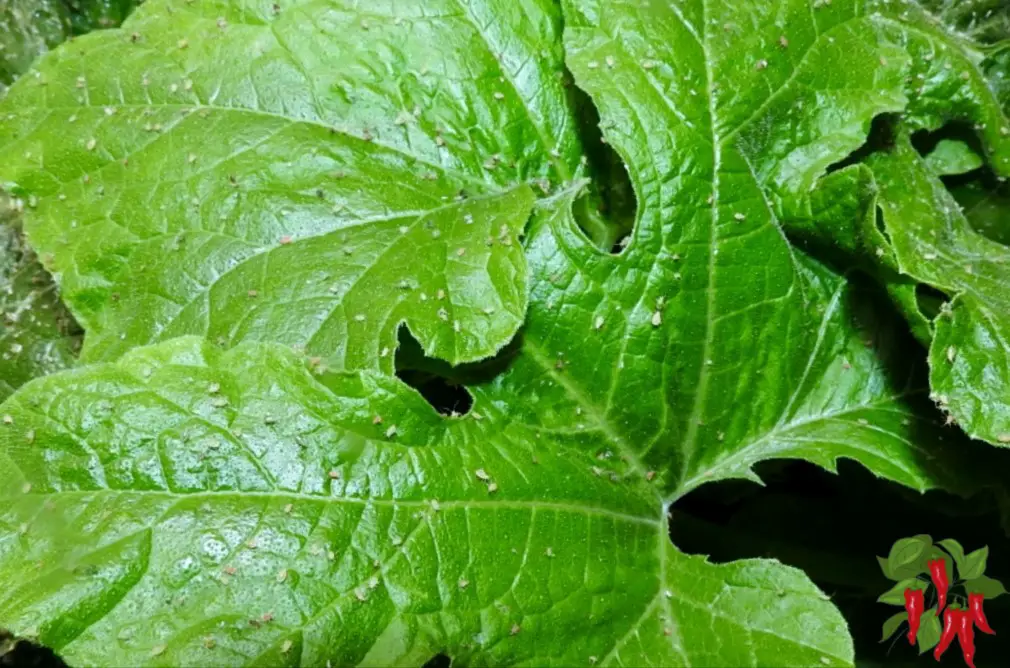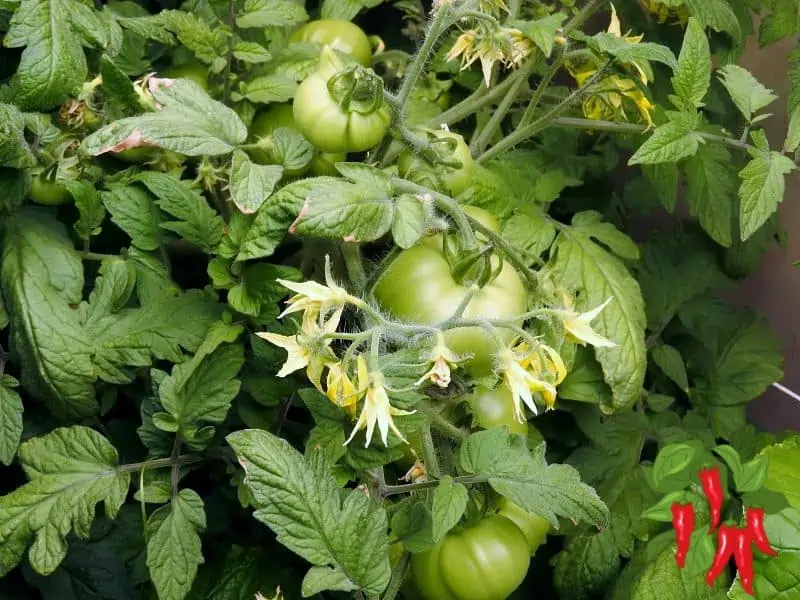This post may contain affiliate links. If you buy something from one of our links we may earn a commission. Thanks

Are you struggling with an aphid infestation on your squash plants or other plants and wondering how to get rid of aphids?
These tiny pests can wreak havoc on your garden, turning your healthy plants into a sticky, yellowing mess.
But don’t worry! In this post, we’ll explore effective solutions to rid your garden of aphids for good.
How To Get Rid of Aphids Key Takeaways
- How to get rid of aphids: Use insecticidal soap or neem oil, ensuring full coverage on infested plants.
- Introduce beneficial insects like ladybugs and lacewings.
- For severe infestations, consider systemic insecticides such as Imidacloprid.
- Regular monitoring and preventative measures can help keep aphid populations under control.
How to Get Rid of Aphids on Squash Plants
Howdy everyone! As you can see, we’re continuing our series on how to grow acorn squash from seed to harvest.
And the focus of this episode is going to be how to get rid of aphids. Let’s dive right in!
Identifying the Aphid Problem Recognizing Aphids
Today, we’re diving into a little bug that’s causing a big fuss in our gardens—aphids.
These tiny, pear-shaped critters can come in various shades, from green to black, and even yellow.
They might be small, but they sure know how to make their presence known.
You’ll typically find these pests clustering on the undersides of leaves and stems, where they set up camp and start causing trouble.
Aphids are sap-suckers—they pierce the plant tissue and draw out the sap, which is the lifeblood of your plants.
As they feed, they excrete a sticky substance called honeydew. This honeydew isn’t just an unsightly mess.
It attracts ants and can lead to the growth of sooty mold, which further hampers your plants’ ability to photosynthesize.
Here’s what to look for:
- Sticky Residue: If you notice a sticky coating on your leaves or surrounding surfaces, it’s likely honeydew from aphids.
- Yellowing Leaves: When aphids suck out the sap, they deprive the leaves of nutrients, causing them to yellow and wilt.
- Curled or Distorted Leaves: Some aphids inject toxins into the plant as they feed, leading to curled or misshapen leaves.
- Presence of Ants: Ants are often found near aphid colonies because they farm aphids for their honeydew.
Recognizing these signs early can help you take swift action to protect your plants from these persistent pests.
Keep a keen eye on your squash plants, especially on the undersides of leaves, where aphids love to hide.
If you spot them, it’s time to roll up your sleeves and get to work!
Understanding the Aphid Life Cycle
Let’s chat a bit about why aphids seem to appear out of nowhere and multiply so quickly. The secret lies in their fascinating and rather sneaky life cycle.
Aphids have a pretty unique way of reproducing. Most of the time, they give birth to live young instead of laying eggs.
This process, known as parthenogenesis, allows female aphids to produce offspring without mating.
Each female aphid is born pregnant and can give birth to up to 50 nymphs within a month.
These nymphs mature quickly, often in just a week during warm weather, and they too can start reproducing soon after.
When conditions are just right, like in the spring and summer, this results in a rapid population explosion.
If things get too crowded or food becomes scarce, some aphids develop wings and fly off to find new plants to colonize, spreading the infestation even further.
Here’s a quick rundown of their life cycle:
- Live Birth: Female aphids give birth to live young, skipping the egg stage, which accelerates their population growth.
- Rapid Maturation: Nymphs mature in about a week during warm weather and can begin reproducing almost immediately.
- Winged Forms: When overcrowded, some aphids develop wings and migrate to new plants.
This prolific breeding is what makes aphids such a formidable pest. They can quickly overrun a plant and, if not managed, spread to other plants in your garden.
So, it’s crucial to keep an eye out and act quickly at the first sign of these pesky bugs.
Natural Remedies for Aphid Control
Insecticidal Soap and Neem Oil
HARRIS Neem Oil Cold Pressed Water Soluble Concentrate
You can use insecticidal soap or neem oil to control aphids. Ensure thorough coverage, including the undersides of leaves, for these treatments to be effective.
Beneficial Insects
Introducing natural predators like ladybugs, lacewings, and parasitic wasps can help control aphid populations.
Chemical Control Options
Organic Pyrethrum
PyGanic Botanical Insecticide Pyrethrin Concentrate for Organic Gardening
An organic option made from chrysanthemums, pyrethrum can be effective but may require repeated applications.
Systemic Insecticides
Imidacloprid and Merit 75 WP are systemic insecticides that get absorbed by the plant and kill aphids when they feed.
This method is highly effective but should be used with caution due to potential impacts on beneficial insects and pollinators.
Prevention and Maintenance
Regular Monitoring
Regularly inspect your plants for early signs of aphids and take immediate action to prevent large infestations.
Companion Planting
Planting aphid-repellent plants like onions, garlic, and chives near your squash can help deter aphids.
Physical Barriers
Using reflective mulch or row covers can help protect your plants from aphid invasions.
Life After Aphids
My aphid invasion is over. The Merit did its trick and plants are recovering nicely. I removed most of the damaged leaves from the first plant and it is regrowing. Its been about a week since treatment. The other plant was barely touched because the aphids did not get a chance to fully spread to it.
Here is a Life After Aphids Video Update for You
Conclusion: Taking Action Against Aphids
Well, folks, we’ve covered a lot about those pesky aphids and how they can wreak havoc on our beloved squash plants.
It’s clear that dealing with these tiny invaders requires a combination of vigilance, natural remedies, and sometimes, chemical intervention.
So, let’s wrap things up and talk about what you can do to take action against aphids and keep your garden in tip-top shape.
Recap of Key Points
We’ve covered quite a bit today about how to get rid of aphids on your squash plants. Here’s a quick recap:
- Recognizing Aphids: Look for small, pear-shaped insects on the undersides of leaves and stems, along with signs like sticky honeydew, yellowing leaves, and the presence of ants.
- Understanding Their Life Cycle: Aphids reproduce rapidly through live births, with each female capable of producing up to 50 nymphs a month. Overcrowding can lead to the development of winged aphids, spreading the infestation.
- Natural Remedies: Use insecticidal soap, neem oil, or homemade solutions like garlic spray and tomato leaf spray. Introduce beneficial insects like ladybugs and lacewings.
- Chemical Options: Consider systemic insecticides like Imidacloprid for severe infestations, but use them responsibly.
Taking Action
Now that you know what you’re up against, it’s time to take action:
- Inspect Regularly: Keep an eye on your plants, especially the undersides of leaves, for early signs of aphids.
- Use Natural Remedies: Start with natural methods like insecticidal soap, neem oil, and introducing beneficial insects to control aphids without harming your plants or the environment.
- Consider Chemical Options: If natural methods don’t work, use chemical insecticides as a last resort, following all safety guidelines to protect beneficial insects and pollinators.
- Act Quickly: The key to controlling aphids is swift action. The sooner you tackle the problem, the easier it will be to manage.
Encouragement to Act
Don’t let these tiny pests get the better of your garden. With a little vigilance and the right strategies, you can keep your squash plants healthy and thriving.
Remember, the sooner you act, the better your chances of preventing a full-blown infestation.
Read our article: Growing Table Queen Squash: Tips and Tricks for Beginners – Stay Green Garden
You might also like: Indoor Apartment Gardening: 15 Point Comprehensive Guide
Take good care of yourselves, happy gardening, and don’t forget, stay green. Alright, I’ll see y’all later. Bye-bye!
Resources for Controlling Aphids
If you want to dive deeper into the battle against aphids and get some expert advice, I’ve gathered a few great resources from reliable .edu websites.
These articles provide comprehensive information on identifying, controlling, and preventing aphid infestations.
Let’s arm ourselves with knowledge and keep those gardens green and thriving!
Helpful Articles
- University of California Integrated Pest Management (IPM) Program
- This resource provides detailed information on aphids, including identification, life cycle, and various control methods.
- Aphids Management Guidelines
- Penn State Extension
- Penn State offers practical advice on natural and chemical control methods for managing aphids in your garden.
- Aphid Control
- University of Minnesota Extension
- A comprehensive guide on aphid identification, life cycle, and effective management practices to keep your plants healthy.
- Aphids in Home Gardens
- Clemson Cooperative Extension
- Detailed information on the types of aphids, their damage, and various control strategies, including cultural, biological, and chemical methods.
- Aphids
Encouragement to Explore
These resources will give you a wealth of information straight from the experts. Whether you’re looking to understand more about aphid behavior, explore natural remedies, or consider chemical controls, these articles have got you covered.
Visit my Amazon Influencer Page for videos and gardening products Grow Your Own Garden










